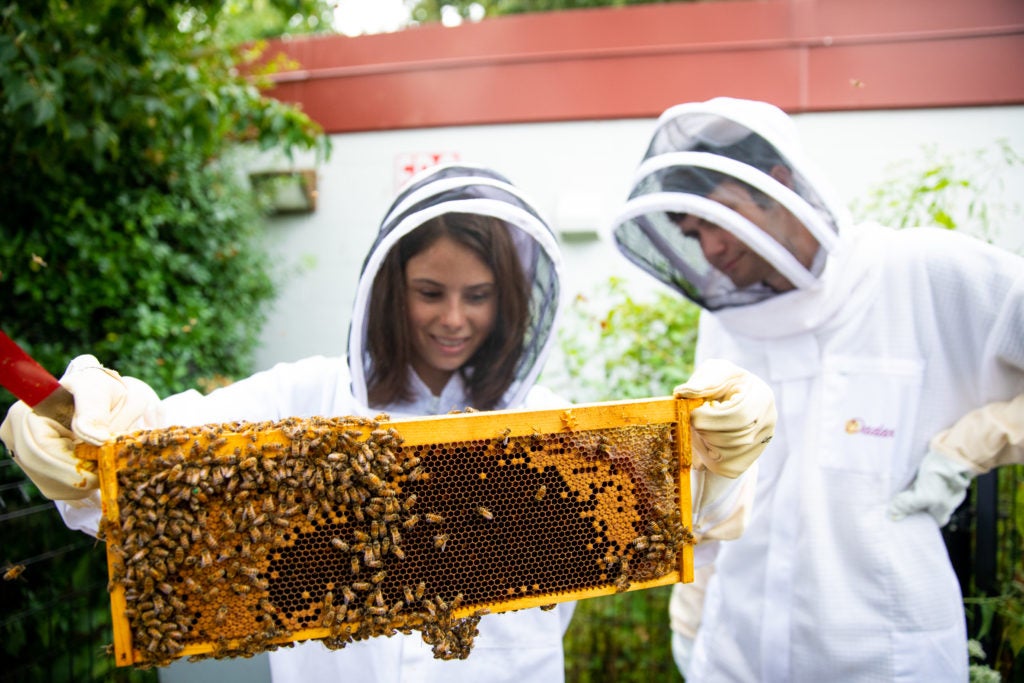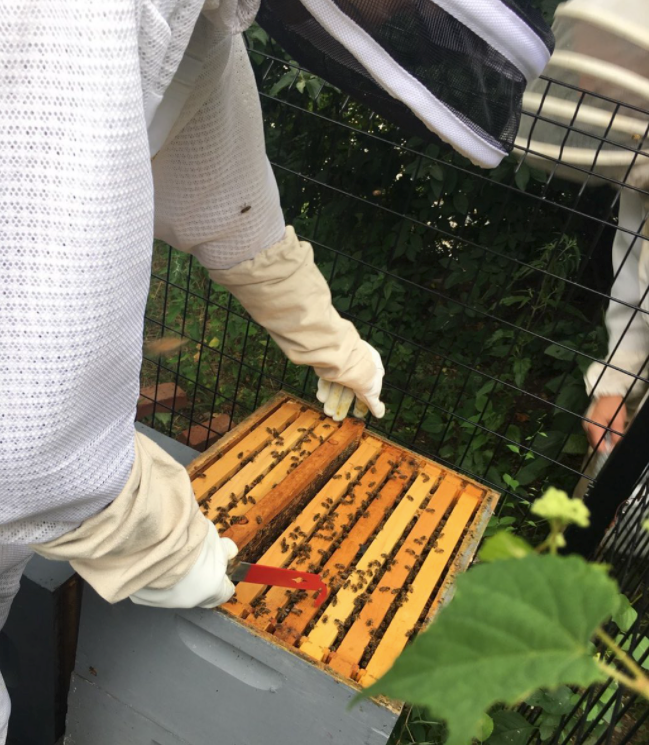Lizzy Nguyen interviewed by Piper Conway
Georgetown buzzes with beekeeping

Did you know Georgetown has harvested 20 pounds of honey from our campus beehives this Fall? Lizzy Nguyen, president of Hoya Hive, discusses beekeeping at Georgetown and the process of becoming a bee campus, harvesting honey, and the importance of protecting pollinators.
How did you get involved with Hoya Hive?
I am a senior in the SFS and a STIA major and physics minor. Ever since my freshman year I have been involved in GREEN (Georgetown Renewable Energy and Environment Network), Georgetown’s largest student organization focused on the environment. I was trying to decide how to become involved in GREEN, and what projects to focus on, when a senior asked whether anyone knew how to beekeep. GREEN had just received a small grant to place beehives on campus, but they didn’t have anyone who knew how to care for the hives. They had the money but no beekeepers. So freshman me thought, ‘why not take a beekeeping class?’ Soon after, I took an intensive beekeeping class at the University of D.C. and that spring we got our first beehives on campus. Over the summer I also installed beehives on my family’s small farm in North Carolina. Then in the fall of 2018, we officially designated Hoya Hive.
How does Hoya Hive fit into other organizations on campus?
Hoya Hive is a part of GREEN and the Georgetown Beekeeping Initiative. The bee team is a group of professors, students, and staff that works to designate Georgetown as a bee campus. In order to earn this designation, we had to meet certain requirements, such as student involvement, faculty research, and coursework requirements, which were established by the pollinator protection society Xerces Society.
How many beehives does Georgetown have?
Hoya Hive has been taking care of 2 hives since we started. We recently expanded to 8 new hives with the new designation of a bee campus. These additional hives are kept for Dr. Bill Hahn (an adjunct professor in STIA) because he is teaching a beekeeping class in the spring, but Hoya Hive has been working closely with Dr. Hahn to help out. All of the hives are located on the western side of campus, near the observatory and the biology lab.
Do you harvest honey from the hives? And, if so, what do you do with it?
Yes we do! We have our own Georgetown honey right now. But unfortunately since the club is not meeting in person, most of it is just in my kitchen. Our first big harvest was in August, and we harvested a lot of honey. You can get up to 70 pounds of honey out of a single hive, but you don’t normally harvest all of that. We only harvested around 20 pounds which we have been distributing to members and professors who have helped us. In the future we are hoping that we can give it out to students to educate and raise awareness, and we are hoping to eventually create products with the honey. For example, a lot of our members are interested in wax products like candles and chopsticks.
Can you tell me a little more about the beekeeping process? How often do you take care of the bees and the hives?
It isn’t often, as the bees are mainly self sustainable. They have been doing this much longer than humans have so they are the experts, not us. But it depends on the season. In the winter you try not to disturb the bees too much. It is the most hands on in the spring when you are installing the bees, and then throughout the summer you go in about twice a month. As a beekeeper you want to make sure you aren’t telling the bees how to live, your job is to make sure they have access to all the resources they need. So you want to make sure there is water nearby, that they are building up enough food, that they are reproducing well, that they have enough space, and that there aren’t pests damaging the hive.
Do you work with all the same types of bees?
There are over 20,000 different species of bees, but humans are mainly concerned with honey bees, officially called Apis bees. We keep honey bees because they survive in the hive formation. A lot of people don’t know that not all bees live in hives. Many native bees live in solitary or family units in holes in the ground or the dirt, so there are a number of different possible habitats. We specifically keep Italian Honey Bees because they are very social, they build up fast, and they have a mild temper.
How has Hoya Hive evolved since it was started in 2018?
When we first started, it was mostly just me and a couple other students from GREEN who were interested in bees and were trying to somehow make the bees survive on campus. My goal was always to create as many beekeepers for life as possible. In order to save the bee population, we don’t need a bunch of perfect beekeepers, we need a lot of imperfect beekeepers and a lot of people who are aware of pollinator protection in general. So I started teaching beekeeping classes through Hoya Hive. We offer the 7-class course once throughout each semester, and we have gotten around 40 students through our course so far. It is essentially a condensed version of the intensive course that I took during my freshman year. The course is taught by students, for students, and it is meant to provide a basic knowledge of pollination. Beyond the expansion to offering an informal beekeeping course, we have also gained a great deal of support from professors as we have continued to develop. We have even gotten the chance to work with facilities in order to build out pollinator gardens, and we are in the works of creating insect hotels for traveling bees and insects.
How has your work shifted since the move to the virtual environment?
It has been a little tough. Right now we are in the last week of our beekeeping classes, and they have all been taught over zoom. The virtual classes have been hard because we want to get people excited about pollinator protection, but it is difficult when everyone is at home and they can’t see the bees. Part of the main appeal to beekeeping is that it is hands on, and you can see ecology in motion. But fortunately, a number of the Hoya Hive members live around the Georgetown neighborhoods so we have been able to meet up to take care of the hives together. We are responsible for living entities so we can’t just drop the ball because things are going virtual.
Why is the practice of beekeeping essential for our well-being?
I think a lot of people don’t necessarily realize that the bees are really unsung heroes because they provide pollination services for so many plants that humans rely on. For example, we can think about almonds. Every year, ⅓ of all the bees in the U.S. go to California to pollinate the almond trees there, and they are shipped from as far as Florida. People do not realize how valuable the ecosystem service of pollination is until it is lost.
I beekeep here in D.C., a major city, but also at home in rural North Carolina. I think a lot of people don’t understand how important bees are in cities specifically. As urbanization continues, there is a big drive for urban greenspaces and urban agriculture, and none of that can happen without urban pollinators. In the District of Columbia there are over 300 beehives, but up until 2014 there was a law that states that you can keep bees in D.C. as long as they stay in their hives. But that standard could never be met because we can’t control the bees, and they need to leave their hives to get food and water and other resources. So I think it is extremely important to incorporate beekeeping practices and pollinator protection into our laws. If we want a chance to protect our ecosystems, we need to understand the critical component of pollination.

How can individuals make a difference even if they aren’t able to have their own hive?
There are lots and lots of things you can do. One of the best things you can do is to have a pollinator garden. Research what’s local in your area and try to grow native plants. You should look out for, and speak up for, the native species around you. Also, stop using pesticides. These don’t only harm little bugs on your plants, they also harm bees. Another thing you can do is avoid monocultures. They are super dangerous because they can create food deserts for bees and they can cause an ecosystem imbalance.
What is next for Hoya Hive? What are you excited about for the future?
One of the best parts of my college experience has been seeing Hoya Hive grow and Georgetown become a bee campus. I would love to see more students become life-long beekeepers. And I am very excited about the potential to scale-up Georgetown honey and bee products in the future.
